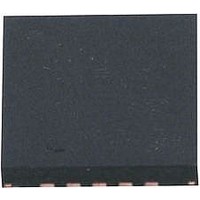LTC4160EUDC-1#PBF Linear Technology, LTC4160EUDC-1#PBF Datasheet - Page 15

LTC4160EUDC-1#PBF
Manufacturer Part Number
LTC4160EUDC-1#PBF
Description
IC, BATT CHRG, Li-Ion, Li-Polymer, 1.2A, QFN20
Manufacturer
Linear Technology
Datasheet
1.LTC4160EUDC-1PBF.pdf
(32 pages)
Specifications of LTC4160EUDC-1#PBF
Battery Type
Li-Ion, Li-Polymer
Input Voltage
5.5V
Battery Charge Voltage
4.1V
Charge Current Max
1.2A
Battery Ic Case Style
QFN
No. Of Pins
20
No. Of Series Cells
1
Rohs Compliant
Yes
Lead Free Status / RoHS Status
Lead free / RoHS Compliant
Lead Free Status / RoHS Status
Lead free / RoHS Compliant
Available stocks
Company
Part Number
Manufacturer
Quantity
Price
OPERATION
For very low-battery voltages, the battery charger acts like
a load and, due to limited input power, its current will tend
to pull V
V
automatically detects that V
battery charge current as needed. This reduction ensures
that load current and voltage are always prioritized while
allowing as much battery charge current as possible. See
Over Programming the Battery Charger in the Applications
Information section.
The voltage regulation loop compensation is controlled by
the capacitance on V
10µF is required for loop stability. Additional capacitance
beyond this value will improve transient response.
An internal undervoltage lockout circuit monitors V
keeps the switching regulator off until V
4.30V and is about 200mV above the battery voltage.
When both conditions are met, VBUSGD goes low and
the switching regulator turns on. Hysteresis on the UVLO
forces VBUSGD high and turns off the switching regulator
if V
voltage. When this happens, system power at V
be drawn from the battery via the ideal diode(s).
Bidirectional PowerPath Switching Regulator –
Step-Up Mode
For USB On-The-Go applications, the bidirectional
PowerPath switching regulator acts as a step-up converter
to deliver power from V
OUT
BUS
from falling below this level, an undervoltage circuit
falls below 4.00V or to within 50mV of the battery
OUT
4.5
4.2
3.9
3.6
3.3
3.0
2.7
2.4
below the 3.6V instant-on voltage. To prevent
2.4
2.7
Figure 2. V
NO LOAD
OUT
OUT
. A multilayer ceramic capacitor of
3.0
to V
BAT (V)
OUT
3.3
OUT
BUS
is falling and reduces the
vs BAT
3.6
. The power from V
300mV
3.9
41601 F02
BUS
4.2
rises above
OUT
BUS
and
OUT
will
comes from the battery via the ideal diode(s). As a step-up
converter, the bidirectional switching regulator produces
5V on V
USB On-The-Go can be enabled by either of the external
control pins, ENOTG or ID. Figure 3 shows the power flow
in step-up mode.
An undervoltage lockout circuit monitors V
step-up conversion until V
backdriving of V
undervoltage lockout circuit prevents step-up conversion
if V
mode is enabled. The switching regulator is also designed
to allow true output disconnect by eliminating body diode
conduction of the internal PMOS switch. This allows V
to go to zero volts during a short-circuit condition or while
shutdown, drawing zero current from V
The voltage regulation loop is compensated by the capaci-
tance on V
required for loop stability. Additional capacitance beyond
this value will improve transient response. The V
age has approximately 3% load regulation up to an output
current of 500mA. At light loads, the switching regulator
goes into Burst Mode
power to V
and PMOS switches shut off. The regulator delivers power
again to V
The switching regulator features both peak inductor and
average output current limit. The peak current-mode
architecture limits peak inductor current on a cycle-by-
cycle basis. The peak current limit is equal to V
a maximum of 1.8A so that in the event of a sudden short
circuit, the current limit will fold back to a lower value.
In step-up mode, the voltage on CLPROG represents the
average output current of the switching regulator when
a programming resistor and an averaging capacitor are
connected from CLPROG to GND. With a 3.01k resistor
on CLPROG, the bidirectional switching regulator has an
output current limit of 680mA. As the output current ap-
proaches this limit, CLPROG servos to 1.15V and V
rapidly to V
be sufficient negative slope on the inductor current when
the PMOS switch is on to balance the rise in the inductor
BUS
is already greater than 4.3V at the time step-up
BUS
BUS
BUS
OUT
BUS
and is capable of delivering at least 500mA.
once it falls below 5.1V.
. A 4.7µF multilayer ceramic capacitor is
until it reaches 5.1V after which the NMOS
. When V
BUS
LTC4160/LTC4160-1
when input power is available, the V
®
operation. The regulator will deliver
BUS
OUT
is close to V
rises above 2.8V. To prevent
OUT
OUT
OUT
there may not
.
and prevents
BUS
BUS
BUS
15
/2Ω to
volt-
falls
41601f
BUS
BUS














